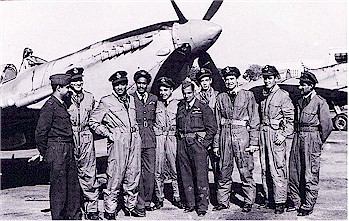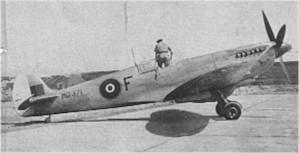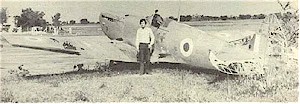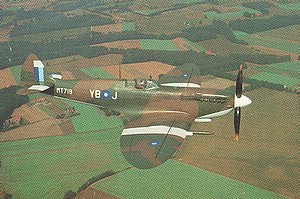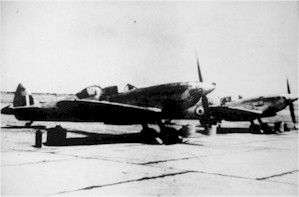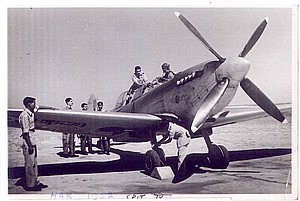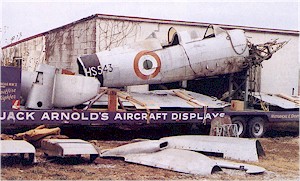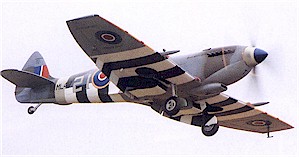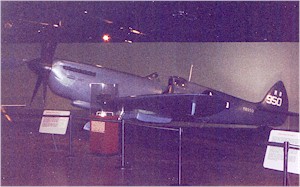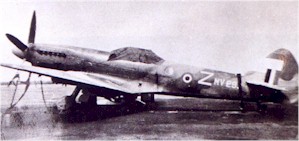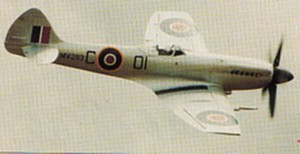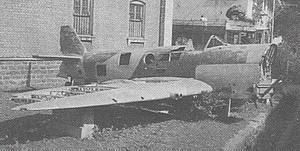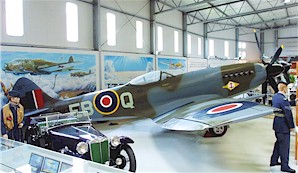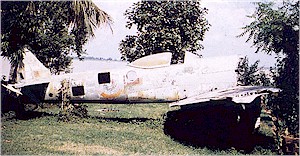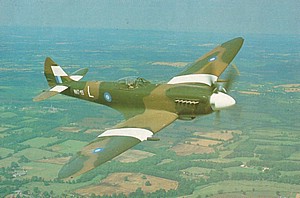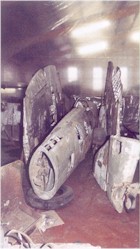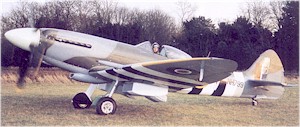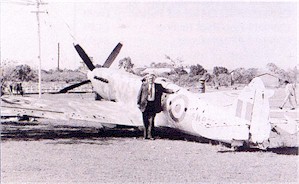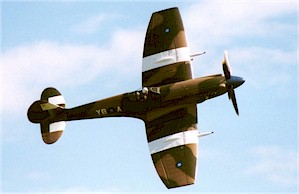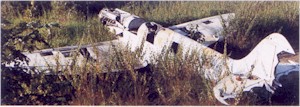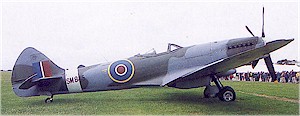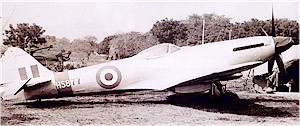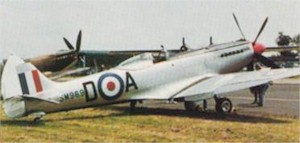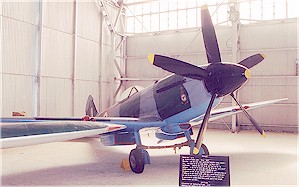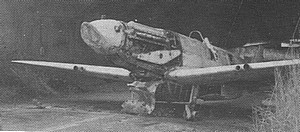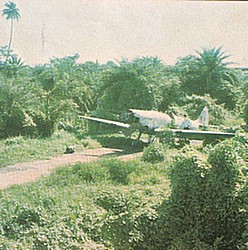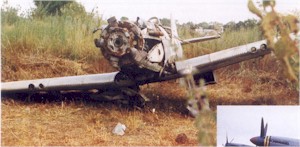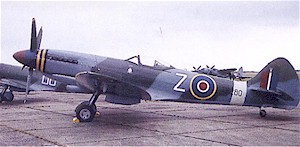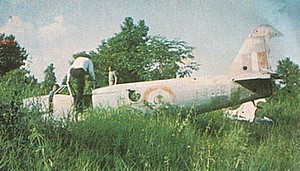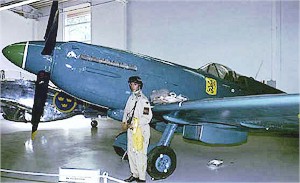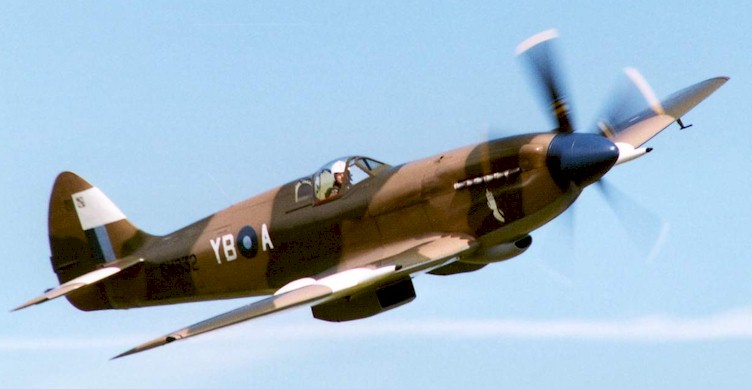
Designed by RJ Mitchell, famed for his previous Schneider Trophy floatplane designs, the prototype Spitfire first flew on 5 March 1936. The first Spitfires entered service at Duxford with 19 Squadron RAF in August 1939. It thus became the only Allied fighter to have entered production before the war and continued to be produced until after 1945. Spitfires served in every theater during World War II and with every Allied Air Force at some time. Almost 40 marks and a host of minor ones came into being with the last Spitfire being delivered on 20 February 1948 to the Royal Hong Kong Auxiliary Air Force. In all 20,351 Spitfires and 2,408 Seafires had been built. The Mks V were produced in the largest quantity (Total 6,479) followed by the Mark IX (5,665).
The IAF and the Spitfire
The IAF was one of the last Commonwealth Air Forces to receive Spitfires in October 1944 (8 Squadron) while most Squadrons re-equipped only in June 1945 with the aircraft remaining on RAF charge with the RAF serials replaced with IAF ones only after Independence (all were re serialled in the HS—batch). This is the main reason why so little is known about their history with the IAF. Coming so late in the war, the Indian Spitfires saw little action during the Second World War, but AFS(I) and No.1 PR Flight’s Spitfires saw some action during the opening months of the desperate defense of the Kashmir valley in the Oct-Nov 47 battles of Badgam and Shelatang).
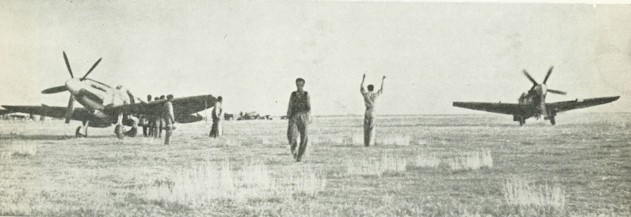 |
|
Mk XIVe taxi back after a mission at Srinagar in November 1947. Note the clipped wings. This is the only photograph of Spitfires in operation from the 47-48 War. Picture Courtesy : PN Sharma / Blitz |
After partition the IAF began officially taking over Spitfires from RAF inventory (hitherto loaned to the IAF) on 29/31 December 1947. Most of these aircraft were relinquished by RAF Squadrons disbanding and going home.
The RAF Spitfire Squadrons that served in India were:
| Sqn No. | Mark | Time Period | Located at | Sqn Code |
| 11 | Mk XIV | Jun 45-Sep 45 | Madurai. | |
| 17 | Mk VIII Mk XIV |
Sep 45 | Madurai | ‘YB’ |
| 34 | PR XIX | Aug 46 to Jul 47 | Stood Down Kohat. | |
| 67 | Mk VIII | Dec 44 | Double Moorings, | ‘RD’ |
| 81 | Mk VIII | Jun 45 | Amarda Rd | ‘FL’ |
| 131 | Mk VIII | Jun 45 | Dalbumgarh, | ‘NX’ |
| 132 | Mk XIV | Aug 45 | Madurai, | ‘FF’ |
| 136 | Mk VII | Jun 44 | Chittagong | HM’ |
| 152 | Mk VIII | Dec 44 | Tulihal | ‘UM’ |
| 155 | Mk VIII | Jan 45 | Palel, | DG’ |
| 273 | Mk VIII | Jul 44 | Cox Bazaar |
‘MS’ |
|
607 |
Mk VIII |
Jan 45 |
Tulihal |
‘AF’ |
|
615 |
Mk VIII |
Jun 45 |
Cuttack |
‘KW’ |
|
681 |
PR XI |
May 45 |
Alipore |
No Code |
In June 1945, Nos 81, 131 and 615 Squadrons were disbanded and their aircraft loaned to the RIAF as were those of 17 Squadron which re-equipped with the Mk XIV. As other Squadrons disbanded, their aircraft went to the RIAF on loan or to storage units to be issued later. The remainder were gradually scrapped. For instance 34 Squadron handed over its PR XIs to the RIAF in August 1946, but its PR XIXs were scrapped a year later instead of being handed over to the IAF.
After the partition of Pre-independence India into Pakistan and India, the IAF set out to rapidly expand the force with deliveries of Spitfires commencing 29/31 December 1947. However, by the end of the first India-Pakistan war (1947-1948), the IAF had already commenced acquiring the Tempest II. Spitfires were generally phased out by 1955 with only No 1 PR Squadron and 14 Squadron continuing to use them till 1957/58.
Spitfire deliveries to the IAF were as follows.
| Time Period | No Delivered | Mark | Serials | Comments |
|
29.12.47 |
14 |
LF VIIIc |
No RIAF Serials |
|
|
29-31.12.47 |
20 |
F/FR XIVe |
HS 351-370 |
Serials Allotted but not painted on aircraft – retained RAF Serials |
|
29.12.47 |
58 |
F/FR XVIIIe |
HS 649-986 |
|
|
Mid 49 |
42 |
F/FR XVIIIe |
HS 649-986 |
Range included other types |
|
31.12.47 |
1 |
PR XI |
Gl No M342 |
|
|
03.06.48 to 15.11.48 |
10 |
HS 534-543 |
Direct Deliveries from Vickers to India |
|
|
02.06.49 |
13 |
PR XIX |
HS693-HS 705 |
|
|
1953 |
1 |
PR XIX |
HS 964 |
|
| TOTAL DELIVERED | 159 |
All RIAF/IAF Spitfire serials were in the HS— series. A brief description of each operated type follows:
Mk Vc | Mk VIII | Mk IX | T Mk IX | PR XI | Mk XIV | Mk XVIII | PR XIX
Mk Vc/Trop: This was the main fighter version powered by the 1,440hp Merlin 45 with many detail changes. The Mk Vc had the ‘universal’ wing with choice of armament plus two 250 lb (130 Kg) bombs. Many sported clipped wings with the tropical filter. This variant was among the slowest Spitfires ever used. Total produced 2,447. All the Mk Vs used by the IAF were powered by the Merlin 66 and arrived Bombay from August 1943. Four served with No 4 Squadron while at least one served with No 1 SFTS (India) in 1946 with the code “88” painted on MA 368 (SOC – 25.4.46.). All IAF Vc were serialled MA—. MA 364 a Vc/Trop is known to have had an incident with then Flg Offr H Moolgavkar (later Air Chief Marshal and Chief of the Air staff). This aircraft taken on charge by the RAF on 25 July 1943, arrived Bombay on 27 September 1943 for 136 Squadron RAF. Its date of transfer to 4 Squadron IAF is not known. However, on 15 January 1945 at Murdania (a beach strip), while aborting take off after an engine failure at 30 ft, Moolgavkar landed wheels down and ran into shallow water and overturned. Moolgavkar was rescued just in time before drowning. The aircraft was SOC on the same date.
Mk VIII: This type followed the interim Mk IX. It was virtually an un pressurized Mk VII in LF (Low Flying, Clipped), F (standard) and HF (High Flying, extended span) versions. Production totaled 1,658. RAF serials of the Indian Mk VIII s (F VIII, VIIIe, VIIIc and LF VIIIc) were in the JF, JG, LV, MD (both PR XI and the LF VIIIc shared this series) MT, MV , NH (shared by VIIIc, FR XIVe and F XVIIIe ) and PA series.
Of the famous names attached to this mark is Plt Offr (later Air Chief Mshl and Chief of the Air staff) LM Katre who while with No 1 Squadron IAF, attempted a dead stick landing after an engine failure on MD 329 during a ferry from Nagpur to Hakimpet, and undershot the field. In the event the aircraft overturned 30 miles south of Nagpur (20043’N 7901’E) and the pilot was seriously injured.
Of the IAF’s Mk VIIIs, two have survived, namely MT 719 a LF VIIIc and NH 631 also a LF VIIIc. In February 2003, an almost intact Spitfire Mk VIII wreckage was escavated from the riverbed at Mullana near Ambala. This aircraft was identified as MV 459.
|
Indian Air Force Mk VIII Survivors Today |
||
|
MT 719 This aircraft was taken on charge by the RAF on 21.6.44 and arrived Bombay on 5.9.44 for No 17 Squadron RAF (YB-J). It transferred to RIAF inventory on 29.12/47 was coded ‘93’ at one time. Its IAF history is unknown but it became a ground instructional airframe- T-17 with the NCC at Jaipur/Sanganer. The hulk was sold to Haydon-Baillie in 1978 with seven other Spitfires auctioned as one lot by the Govt of India. Today it is registered in the USA as N719 MT. |
||
|
NH 631 The only flyable Spitfire in India, it began life with the RAF on 16.12.44 and arrived India on 19.2.45 for 151 OTU. It was loaned to the IAF around 5.46 and is known to have served with Nos 9 and 2 Squadrons IAF. It was finally transferred to the RIAF on 29.12.47 and moved to No 1 BRD on 22.11.49 and then to HQ Maintenance Command flight at Kanpur in 1950. After being scrapped, it was recovered by Air Cmde Harjinder Singh (the first “Hawai Sepoy” or Airmen of the IAF) and was test flown by the great Suranjan Das (later of HAL Marut fame) before being flown by Air Cmde Harjinder Singh to Ambala to receive his IAF wings brevet. The aircraft carries a plate under the nose carrying the inscription “Plumber” as this was the call sign Of Harjinder Singh (Plumber 11). This aircraft was moved to the IAF museum in 1967. During the IAF’s Golden Jubilee on 8.10.82, the Spitfire (along with a Harvard, Tiger Moth, HT-2 and Vampire 52) was restored using Dakota, MiG 21, Kiran and Otter parts and flown as part of the IAF’s Historic Flight till 1989. During its “second birth” in the 1950s the aircraft would most probably have been painted in an all silver scheme as shown below, but was painted incorrectly in the scheme that it appeared-in in 1982.
|
||
|
MV 459 MV 459 was a LF VIIIc (Merlin 66) TOC RAF 16.9.44 Arrived Bombay 8.12.44 for No 8 RFU ACSEA. to RIAF 1946 AFS(I). engine cut belly landed river Mullana village 10 m from Ambala on 23.5.47. declared cat FA/E P/O A D’Cruz OK. SOC 26.6.47 The aircraft was left at the crash site by the recovery team and it resurfaced during some digging in February 2003. Subsequently a team from Ambala Air Force Station visited the site and recovered the aircraft and conducted an external restoration.
|
Mk IX : This was the urgent version to counter the Luftwaffe’s Fw 190 high altitude performance. A stop gap version to the definitive Mk VIII (which was the aircraft initially planned to counter the Fw 190 threat). It was essentially a quick lash up of the Merlin 61 with the Mk V airframe (first two prototypes- AB 196 and 197). An extra radiator was fitted underneath the port wing to house the intercooler and oil cooler finally giving a symmetrical appearance to the Spitfire. A twin 20 mm and twin 0.5in version also formed a small total of the 5,665 produced. The Mk IXs handed over to the RIAF were serialled in the MH, MJ, MK, and ML series. Sadly none of the Indian Mk IXs have survived today.
T Mk IX : After the second world war, Vickers Armstrong contracted with the RIAF to modify ten Mk IXs into two seat trainers by adding a rear, raised seat and moving the front cockpit forward by 13 ½ in. These were the only new build Spitfires received by the RIAF. The RIAF received the T Mk IXs from 11.48 to 9.49.
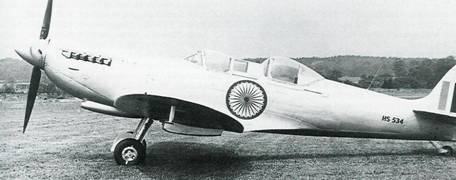 |
Spitfire T Mk IX HS 534 (ex RAF MA 848) was the first of the batch of ten seen in the short lived Chakra markings before delivery. |
All aircraft went to AFS (India), later SFTS at Ambala. The only other Air force to receive such aircraft was the Irish Air Corps. The original RAF serials and the IAF serials later applied are detailed below.
Table showing Serial numbers of T Mk IXs delivered to India
|
RAF |
Indian |
Last Usage Noted |
|
MA 848 |
HS 534 |
|
|
MH 432 |
HS 535 |
|
|
MJ 177 |
HS 536 |
|
|
MJ 276 |
HS 537 |
|
|
MJ 451 |
HS 538 |
Hakimpet 1952 |
|
MJ 518 |
HS 539 |
Hakimpet 1953 |
|
MK 172 |
HS 540 |
|
|
MK 176 |
HS 541 |
|
|
MK 298 |
HS 542 |
Hakimpet 1953 |
|
ML 417 |
HS 543 |
Hakimpet 1953 -> AFMuseum |
Only One T Mk IX has survived.
PR Mk XI: This was the unpressurized version of the PR Mk X version. A Merlin 63A replaced the Merlin 77. Total 471 produced. The only IAF units to operate the type were Nos 6, 7 and 15 Squadrons, No 15 being raised on the type in Aug 51. Ex RAF serials of this type were in the MB, PA and PL series with a few Mk VIIIe sharing the PA letters. One PR XI airframe –
|
Mk XI Survivors |
||
|
PA 908 was handed over by 681 Squadron RAF on 29.12.47 after being declared BER on 9.5.46. Thus this aircraft never flew with the RIAF but immediately became a ground instructional airframe-M-342 at Allahabad. It was found in Poona in 1984 and sold to Jeet Mahal of Canada and today lies at the USAAF museum at Dayton Ohio painted as MB 950.
|
| With a Hurricane IIc and a Mosquito FB IV in the background, a Spitfire PR Mk XI of 681 Squadron RAF is seen in the RAF PR blue scheme with SEAC markings at Monywa, Burma in ’44. These very aircraft were handed over to 6 and 7 Squadrons RIAF in 1945 and may have formed the basis for the raising of 15 Squadron RIAF on PR XIs in Jan 53. | 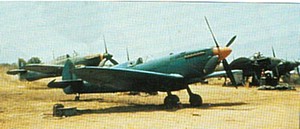 |
Mk XIV: With the success of the experimental installation of the Griffon engine on the Mk V airframe (called the Mk XII), a completely new redesign of the Spitfire was planned around the MkVIII airframe with a new wing and the Griffon engine. This redesign was to appear as the Type 394, Mk XVIII. However, long before the new fighter appeared, there was an operational demand in 1943 for a fighter capable of greater performance at higher altitudes. To meet this demand, yet another type was evolved by mating the Griffon engine and the Mk VIII airframe. The result was the type 379 Spitfire Mk XIV. As had been the case with the Mk IX, built as a “stand in” for, but in larger numbers than the Mk VIII, so the Mk XIV was built in greater numbers than the Mk XVIII. Thus the MK XIV became the first to be fitted with a 2,050 hp Mk65 Griffon with deep symmetrical radiators and five bladed propellers. The completely redesigned airframe featured a new fuselage, broad chord fin, inboard ailerons and retractable tail wheel. The F XIV had twin 20mm and four .303 guns while the F XIVe had the twin 20mm plus two .5in gun arrangement. The FR XIVe had the same guns, cut down rear fuselage and teardrop hood, clipped wings, F24 camera and extra fuel. Production totaled 957. Almost all IAF units operated this type. Ex RAF serials were in the MV (shared with VIIIc), NH, and RM, RN, TX and SM (shared with XVIIIe also) series.
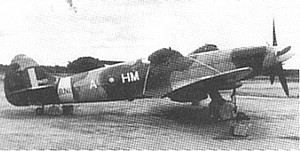 |
Spitfire F Mk XIVe (Griffon 65) RN 193 was taken on charge by the RAF on 10.2.45 and arrived Bombay on 15.5.45 for No 136 Squadron RAF “HM-A”. Here it is seen at Kuala Lampur in post war tail band. This aircraft was handed over to the RIAF in 1947 and served with the No 2 (India) Group Command Flight (still in H-MA markings). This aircraft was disposed of on 25.9.47. |
Of the famous names attached to the Mk XIV was, then, Squadron Ldr Nur Khan (later Air Mshl and Chief of Air Staff, Pakistan Air Force). Who, while carrying out an air test on RN 133 (ex ‘FF-B’ No 132 Squadron RAF) on 28.7.47 with No 4 Squadron RIAF at Iwakuni, suffered a tyre burst and the aircraft was declared Cat FA. The aircraft was SOC on 24.7.48.
| NH 803 arrived Karachi on 16.10.45. Transferred to 9 Squadron RIAF 1946. U/C failed to lock down on 20.2.47 and collapsed on landing at Nagpur. Flg Offr Zaheer-OK. Aircraft SOC 26.6.47. | 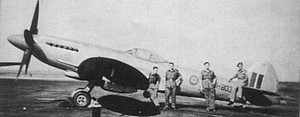 |
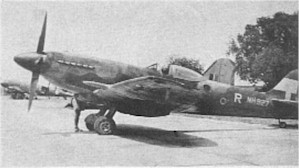 |
NH 927 was a FR XIVe (Griffon 65) clipped wing which was TOC/RAF on 6.5.45, arrived Karachi 14.10.45 to ACSEA, India census 5.46 with 6 sqn. This ac is seen at Chakeri./ Kanpur in Aug 47 (No 320 MU). This picture was taken at Chakeri just before the aircraft was destroyed by dropping Concrete blocks on it on 28.8.47. |
Six Mk XIV have survived to date. These are as follows:
|
Mk XIV Survivors |
||||
|
MV 262 Ex No 202 SP RAF
|
||||
|
MV 293 To RAF 27.2.45 – Loaned to 8 Squadron RIAF 15.10.45. Landed tail wheel retracted at Hakimpet 12.5.46 (Plt Offr SM Ahmed). To IAF inventory 29.12.47. Became ground instructional airframe ‘T-20’ at IAF technical College Jalahalli. Sold War Birds of Great Britain in 1978. First flight 14.8.92 with spurious code ‘OI-C’ but original serial MV 293. Airworthy.
|
||||
|
MV 370 To RAF 10.2.45. Arrived Bombay 14.10.45 To AFS (India) 5.46 and IAF inventory 29.12.47. Ground instructional airframe T-44 at Nagpur 1970. Hulk recovered by Hayden- Baillie in 1977. Restored to static condition for Luftfahrtmuseum, Laatzen, Hanover, Germany 1992. Displayed as MV 370/’EB-Q’ (Squadron code for No 41 Squadron RAF)
|
||||
|
NH 749 Taken on Charge RAF – 26.2.45. Arrived Karachi 28.7.45 and loaned to AFS (India) 5.46. Transferred to RIAF Dec 47. Coded ‘54’ and ‘D’ at different times. Became ground instructional airframe T3 at the IAF Technical College at Jalahalli but recovered from Patna AFB by Haydon- Baillie in 1977. Restored at Cranfield and flew again on 9.4.83. Presently in USA as NX749DP. Airworthy.
|
||||
|
NH799 Taken on charge RAF 14.3.45.Arrived Karachi 28.7.45. Loaned to 9 Squadron IAF 5.46. Engine cylinder blew during ground run 27.2.47. Declared Cat E. Transferred to RIAF Dec 47. Subsequent history not known Sold by IAF in 1981 to Doug Arnold and restored in 7.93. To New Zealand 3.94 and registered ZK-XIV. Airworthy. The aircraft had an accident in 1996 and is currently under restoration.
|
||||
|
SM 832 Taken on charge RAF- 1.3.45. Arrived Karachi 5.45. Transferred to RIAF 12.47 to AFS (India). To Indian Military Academy Dehra Dun 1953/54. Rediscovered in 1972 Recovered by Haydon-Baillie in 1978. Restored and flew again 22.5.95. Marked SM 832/’YB-A’. To France 2.98 as F-AZSJ and operated out of Dijon. Airworthy.
|
Mk XVIII: Almost identical in appearance to the Mk XIV, the Mk XVIII incorporated a new wing design, as opposed to the “universal” wing fitted to the interim Mk XIV. Armament remained the ‘E’ wing version. The Mk XVIII carried an additional two vertical cameras over the single oblique installation of the MkXIV and all aircraft had full span wings. Initially the MkXVIII s flew with the Griffon 65 until the Griffon 67 was introduced with an additional 300 hp. Becoming the most powerful Spitfire ever, it will also be remembered as probably the most beautiful. Production totaled 300. Ex RAF serials commenced with NH (shared with Mk XIVe and VIIIe), SM and TP. Since the Mk XVIII arrived in the late 40s, many have survived.
A total of nine ex IAF Mk XVIIIs are on the war bird register today. These are detailed below:
|
Mk XVIII Survivors |
||||
|
SM 845 – Thisaircraft was taken on charge by the RAF on 28.5.45. Arrived Karachi 11.2.46. Transferred to RIAF Dec 47. Almost certainly served with either 2, 9 or 101 Squadrons. RIAF serial HS687. Found Kalaikunda and recovered by Historic Flying Limited. Flew after restoration on 7.7.2000, registered G-BUOS. Airworthy.
|
||||
|
SM 969 This aircraft was taken on charge by the RAF on 30.8.45 and arrived in Karachi on 11.2.46. Loaned to No 6 Squadron RIAF. Thisaircraft crashed on landing at Ranchi on 20.12.46 Recovered by Haydon-Baillie in 1978 and was restored as D-A (for Doug Arnold, owner) with registration G-BRAF and flew 12.10.85. Currently in storage but airworthy.
|
||||
|
SM 986 Became HS 986, TOC RAF 11.10.45. To 47 MU 8.47. Sold to RJ Parkes for RIAF 6.49. No 1 BRD IAF until 5.52. Then 14 Squadron 5.52 and back to 1 BRD in 6.54. To IAF museum in 1967 and extant.
|
||||
|
TP 263 Became HS649. TOC RAF 2.6.45. Arriving Karachi on 31.1.46. TO RIAF Dec 47. Service history not known. Coded ‘NL’ at one time. Was part of a Haydon-Baillie recovery in 1977 from Kalaikunda. Fuselage sent to UK and wings to USA. Converted to high back and exchanged with National War and Resistance museum, Overloon, Netherlands and marked as NH 649 in lieu of a known RAF serial (at that time).
|
||||
|
TP 276 Became HS 653. TOC RAF 20.6.45 Arrived Karachi 12.2.46. To RIAF Dec 47. Coded ND at one time. Service history not known. Discovered at Barrackpore in 1977. Recovered by Haydon-Baillie in 1978 and sold to Rudolf Frasca. Restored and located at Frasca Air Museum, Urbana, Illinois, USA.
|
||||
|
TP 280 Became HS 654. TOC RAF 19.6.45. Arrived Karachi 30.3.46. To RIAF Dec 47. Served 9 Squadron and AFS (India). Discovered in Kalaikunda in 1977. Coded NG at one time. Recovered by Haydon-Baillie in 1977 and sold to Rudolf Frasca. Restored by Historic Flying Limited in 1992 and UK registered G-BTXE. Back to USA registered N280TP and flown as TP280/Z. Located at Frasca Air Museum, Urbana, Illinois, USA.
|
||||
|
TP 298 Became HS 662. TOC RAF 17.7.45 Arrived Karachi 12.2.46. To RIAF Dec 47. Service history not known. Found Kalaikunda in 1977. Recovered Haydon- Baillie 1978. Restored as N41702 and then N93232Z. Fatal crash on 19.4.94. Currently again under restoration.
|
||||
|
TP 367 Became HS 674. TOC RAF 22.10.45. Arrived Karachi 31.1.46. To RIAF Dec 47. Coded ‘NB’ at one time. Service history not known. Found IIT Kharagpur in 1979. Initially sold to Jeet Mahal of Vancouver , Canada but export not allowed. Re sold to ‘sandy’, Bedfordshire, UK 17.8.94. Currently with JM Limbeuf Rouen, France. |
||||
|
TZ 219 Became HS 683. TOC RAF 8.12.45 Arriving Karachi 11.2.46. To RIAF 31.12.47. Service history not known. Presented by AVM Harjinder Singh to Punjab Engineering College, Chandigarh in the fifties. HS 674 painted on. Believed to be a composite airframe of both HS 674 and HS 683.
|
PR Mk XIX: This was the final photo recce version 2,050hp Griffon 65 with the unpressurised cockpit then the 67 with pressurized cockpit. This aircraft with deep slipper tank could make a 2900 Km trip. It was also the last of the Spitfire marks flown by the RAF (1 Apr 54). Production totaled 225. RAF serials of aircraft handed over to the RIAF commenced with the serials PM and PS. Only one ex RIAF/IAF PR MK XIX has survived.
|
Mk XVIII Survivors |
||
|
PM 627 This Spitfire became HS 694 and was TOC RAF 20.9.45. It moved to No 9 MU on 4.6.52 and was sold to Vickers Armstrong on 15.2.53 and then onto No 1 PR Squadron IAF in 1953. It moved to No 1 BRD in 1955 and back to No 1 PR Squadron till 1957 and then stored at Palam till 1970. Recovered to Canada on 3.2.71 and then to Swedish AF Museum in 1982.
|
| A PR MK XIX of 101 PR Flt at Palam in the early 1950s. Note overall PR blue scheme and white band on tail. Thisaircraft appears to have PR blue spinner as well, although other commentators have said that these were black. | 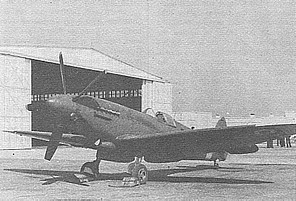 |
Fifteen Sixteen units of the IAF had the pleasure of operating the Spitfire. These were Nos 1, 2, 3, 4, 6, 7, 8, 9, 10, 12, 14, 15, 16 Fighter and No 1 PR Squadron (later 101 Squadron) and Advanced Flying School (India), Ambala, later renamed to No.1 Air Force Academy, and lastly the Conversion Training Unit, Hakimpet. and No 2 FTS (Flying Training School).
No 1 Squadron (Tigers) : Formed 01.4.43 at Drigh Rd with Wapiti IIa for Army Co-op then Hart, Audax and Lysander. Converted to Fighter unit with Hurricane Mks I and IIb from Sep 44. With Spitfire LF VIIIc from Nov 45 at Kohat. Samungli 02 Apr 46, then Yelahanka 18 Jun 46. Detachment at Miranshah from 27 Oct 45 to 7 Apr 46 and again from 27 Mar 47 with few FR XIVe. Reduced to 8 from 16 MkVIII from 15 May 47 and moved to Peshawar. Re equipped Tempest F.II Jul 47 and assets transferred to RPAF 15 Aug 47. Re-raised in 1951 by renumbering No.15 Squadron on 26 Jan 1953. Flew Vampires, Mysteres and MiG-21s. Today flying Mirage 2000 H/TH.
| 8 Squadron pilots ‘scramble’ and ‘brief’ for a photo shoot at Samungli in 1946. Note SEAC bands still applied to their Mk VIIIe s. The pilots are Haider, Thandi, Zahid, Phillip, Beg, Subia, Mendoza and Aziz. | |
No 2 Squadron (Winged Arrows) : Formed 1.4.41 at Peshawar with Wapiti IIa for army co –op, then Lysander from 24 Nov 41. Converted to Tac R role with Hurricane IIb from 7 Sep 42 then Spitfire LF VIIIc from Jan 46 at Kohat. Samungli from 9 Nov 46 then Poona 10 Feb 47. Manned detachments at Miranshah from 2 Apr 46 to 6 Jun 46 then Aug 46. Reduced to 8 from 16 Mk VIII 31 May 47. Re equipped F/FR XVIIIe Dec 48 till Oct 53. Currently flying MiG 27 ML.
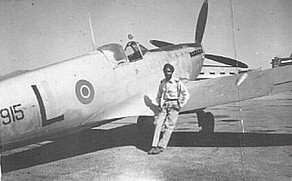 |
A No 2 Squadron LF VIIIc in the post war silver scheme in Indian markings. Thisaircraft (almost certainly MT 915, Merlin 66) was taken on charge by the RAF on 15.11.44 and arrived India on 4.2.45. Reflected in RIAF India census of 5.46, taken on charge by 2 Squadron from 20.1.46 till 4.47. Retd RAF and struck off charge on 31.7.47. Its IAF service is unknown. |
| Another view of a 2 Squadron F VIII in SEAC scheme but with type ‘D’ Indian roundels and single letter ID. The serial is a mystery as no ‘NT —‘ existed and no VIIIs existed in any T—- serials. | 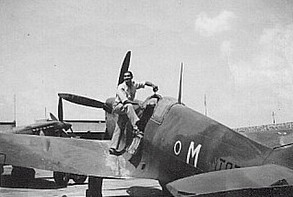 |
No 3 Squadron (Cobras): Formed 1.10.41 as FR unit at Peshawar with Audax I. Converted to FB role with Hurricane IIc from Nov 43. With 16 LF VIIIc from Nov 45 at Risalpur and at Kolar from 2 Jan 46. Re equipped with Tempest F.II from Sep 47. Currently flying MiG 21 Bison (Bis Upgrade).
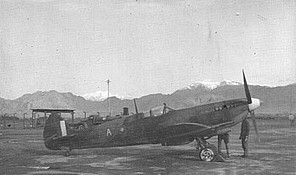 |
A 3 Squadron MkVIII in SEAC markings but no White ID bands (onlyaircraft in theater would have these applied) rests at Peshawar. Note white spinner with a colored tip (red?) |
No 4 Squadron (Oorials): Formed 1 Feb 42 as Tac R unit at Peshawar with Lysander II. Then Hurricane IIc for FGA from Aug 43. Spitfire LF VIIIc from Jun 45 at Yelahanka. Some F/FR XIVe from Jan 46 to Mar 46. Embarked for Japan on 6 Mar 46 as part of Commonwealth occupation forces, based Iwakuni from 31 Mar 46 with F/FR XIVe and Miho (Hiroshima) from 6 May 46. Returned to India 19 Jul 47 leaving all aircraft in Japan. Re equipped Kanpur/Chakeri on Tempest F.II. Today Flying MiG 21 Bis.
|
No 4 Squadron RIAF embark HMS Vengeance for trip to Japan end Mar 46. One FR Mk XIVe wears the serial RN 202? And the other MV2–. Theseaircraft sport the RAF ‘C’ type roundel whilst many other 4 Squadronaircraft sported both the silver and camouflage schemes with the SEAC Blue and Sky Blue roundel but no white ID bands in Japan. |
No 6 Squadron (Dragons): Formed 1.12.42 at Trichinapoly with Hurricane IIb for Tac R. Converted to Spitfire LF VIIIc and F/FR XIVe from Nov 45 at Kohat (also had few PR.XI). Ranchi from 10 Jan 46 disbanding on 30 Apr 47. Reformed next day at Mauripur (Karachi) as Dakota unit. Ceased to exist on 15 Aug 47 pending formation as PAF unit. Later reformed as IAF Liberator unit. This unit had the honour of being commanded by Squadron Ldr JC Varma DFC (1.8.46 to 11.1.47), the only other Indian (sources state that Flt Lt MS Pujji whilst with 43 Squadron RAF flying the Spifire Mk Vc claimed two Bf 109s destroyed and one probable over Europe in 1943) to bring down an enemy aircraft in WW II (a JAAF Nakajima Ki-43 Hayabusa (Oscar) flown by Cpl Tsuneo Nabeta of the 204th Sentai on 15.2.44 over Taung Bazaar). Currently flying Jaguar M.
No 7 Squadron (Bison, later Battle Axes): Formed 1.12.42 at Vizagapatnam with Vengeance I, later III. Hurrican IIc from Nov 44. Converted to Spitfire F/FR XIVe (also some LF VIIIc and PR XI) from Dec 45 to Mar 46 at Gwalior. Then Kohat, Miranshah and Risalpur on 30 Apr 47. Re equipped with Tempest F II at Agra from May 47. However re equipped with Spitfires (due spares problems with Tempest) which served till early 49 alongside Vampires and took part in Kashmir operations in 47/48. Currently flying Mirage 2000 H/TH.
|
The earliest record of an aircraft carrying the Battle Axe emblem – A Spitfire XVIII borrowed by Air Marshal R Ivelaw-Chapman for a visit to Kanpur. Gp Capt Harjinder Singh is the receiving Officer. |
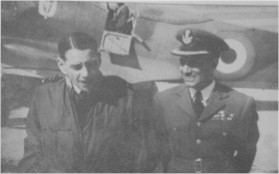 |
No 8 Squadron (The Eighth Pursoot): This was the only IAF squadron to be equipped with Spitfires and fly them in action during WW2. Also formed 1.12.42 with 7 Squadron at Trichinapoly with Vengeance I and III. Spitfire LF VIIIc from Jul 44 at Samungli. Operated four Mk V/Trop in Nov 44 from Amarda Road pathfinding for Allied P-51s and P-47s. Nidania from 29 Dec 44 and Baigachi from 23 Feb 45. Flew operations from ‘George’ strip south of Cox Bazaar from 3.1.45. Two flights operated from Akyab forward strip carrying out patrols along the beachs and covered the landing of the 26 Indian Div at Ramree island. Embarked for Rangoon 19 Jul 45. Took over 16 Spitfires VIIIs from 607 Squadron RAF at Mingaladon. Carried out “cab-rank” patrols with one 500 lb bomb alongside RAF Thunderbolts against Japanese forces escaping west of the Rangoon-Toungoo Rd. Spitfires also dropped supplies to the Burmese guerillas of force 136 behind enemy lines. The last operational sortie by a RIAF Spitfire was on 13.8.45 when a lone aircraft dropped supplies to a small groups of V-Force men in the Kyaukki area. 8 Squadron Spitfires escorted the two Japanese aircraft transporting Lt Gen Numata from Elephant Point to Mingaladon outside Rangoon to sign the instrument of surrender. The Squadron returned to India 24 Jan 46 then Trichinopoly with F/FR XIVe on 4 Feb 46. Moved to Kolar and re equipped with Tempest FII from Oct 46. last Spitfire left behind on moving to Poona on 13 May 47. Currently flying MiG 21 FL.
|
A Spitfire FR XIVe clipped wing MV 364 ‘A’ of 8 Squadron at Kolar in 1946. Note the SEAC markings with ‘D’ type roundel in Indian Colours. The exact date when Indian markings were applied is not known. However, this appears to have occurred around mid-1946. |
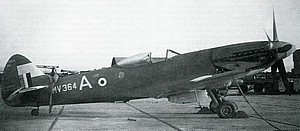 |
No 9 Squadron (Wolf pack): Formed 3.1.44 at Lahore with Hurricane IIc. Converted to LF VIIIc from May 45 at Baigachi. Then to Ranchi Oct 45 and to Hmawbi /Rangoon in Nov 45 with some F/FR XIVe. Back to Willingdon in Jan 46 and Gwalior in Feb. Totally re equipped with F/FR XIVe , moved to Peshawar in Mar 46 and Bhopal on 14 Jan 47. Reduced to 8 XIVs and then re equipped with Tempest F II and transferred to RPAF on 15 Aug 47. Re raised as an RIAF unit in 1948 on F/FR XVIIIe and served until Oct 53. Re-raised as a Folland Gnat Unit in 1964. Currently flying Mig 27 ML.
No 10 Squadron (Daggers): Formed 20 Feb 44 at Lahore with Hurricane IIc. Converted to Spitfire LF VIIc from May 45 at Yelahanka (six LF VIIIc from 17 Squadron RAF). Moved to Kajamalai/ Trichinapoly May 45 and then to Ulunderpet in Nov 45. Then to Hmawbi on 22 Nov 45 and back to Baigachi and Barrackpore on 15 Feb 46. Finally to Chakeri on 15 May 47 to convert to Tempest MkIIs. Currently flying MiG 27 ML.
No 12 Squadron (Yaks): Formed 1.12.45 with LF VIIIc at Kohat. To Risalpur on 28 Jan 46 and Bairagarh on 23 Jun 46, converting to Dakotas from Aug 46. Currently flying AN-32.
No 14 Squadron (Fighting Bulls): Formed 15 Aug 51 with F/FR XVIIIe at Ambala. To Barrackpore in 52 and back to Halwara in 57. Became last piston engined front line unit of the IAF. Converted to Hunters in 1957. Currently flying Jaguar S.
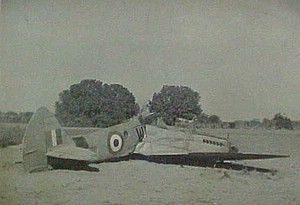 |
A No 14 Squadron FR Mk XVIIIe lies with a broken back after overshooting the Runway at Halwara. Note the black tail band (also wing tips) applied to all Spitfires and Tempests at that time |
No 15 Squadron (Flying Lancers): Formed 20 Aug 51 at Ambala as PR unit with PR Mk XI FR XVIIIe. Disbanded Jan 53, Spitfires going to No.1 Squadron. Re raised, Currently Mig 21 Bis unit.
No 16 Squadron (Black Cobras); Formed in 1951 with F/FR XVIIIe. Ceased to operate Spitfires in 1954. Currently operating Jaguar S.
No 101 Squadron (Falcons): Formed as No 1 PR Flt in Jan 48 at Jammu with FR XVIIIe and then with PR XIX from 49. Disbanded 1958. Re raised in 1968 on Su-7s, currently flying MiG 21 M in PR role.
Advanced Flying School (India): Formed 1 Apr 46 from No 1 (Indian) Advanced Flying Unit, No 1 Service Flying Traing School and No 151 OTU at Ambala and absorbed into RIAF on 1 Jun 47. Flew LF VIIIc, F/Fr XIVe and XVIIIe and finally T.IX from 1949 to 51. AFS was renamed to No.1 Air Force Academy in 1950.
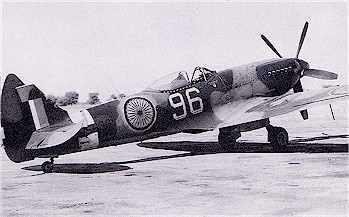 |
A Mk XVIII of the AFS (India) Ambala in the post ‘chakra’ markings hastily applied over the earlier type ‘C’ roundel. Most Spitfires in the training role carried a double digit ID numeral under the cockpit. This aircraft is HS636 and is the first Spitfire in IAF service to carry a HS serial |
|
Spitfire FR XIVe NH 786 of the SFTS RIAF Ambala seen at Peshawar during 1946. It was written off on 2.8.46 when the engine failed during aerobatics and the aircraft was force landed 12 miles east of Ambala Plt Offr SMS Haque being injured. |
|
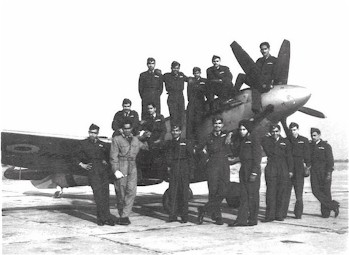 |
Flight Cadets pose with a Spitfire FR XVIIIe at Ambala. Photo Courtesy : Wg Cdr IM Chopra (Retd) via Gp Capt Kapil Bhargava |
No 2 Flying Training school (FTS): Formed at Jodhpur, temporarily used T.IXs from 1949 to 57.
Conversion Training Unit: Formed at Hakimpet (N of Secunderabad) in August 1951, taking up aircraft from No.1 Air Force Academy which had moved to Begumpet. Flew LF VIIIc, XVIIIe and T.IXs from 1951 to 55. A total of ten Pilot courses (Nos.55 to 64) were trained on the Spitfire, with some batches sharing the load with Tempest IIs and Vampire FB52s. Of these ten courses, three (59,60,61) were solely on Spitfires. Renamed Jet Training Wing and subsequently to Fighter Training Wing. Today it is known as Air Force Station Hakimpet and flies Kiran Mk1As and Mk IIs.
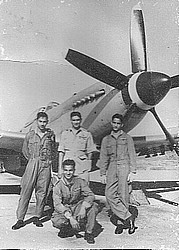 |
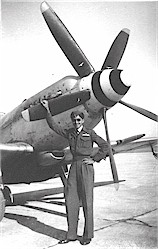 |
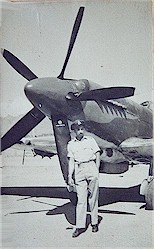 |
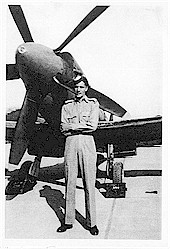 |
| Wg Cdr Don Michael and his pupils at Conversion Training Unit, Hakimpet. Plt Offr (later Air Mshl) Prithi Singh is on his left. Note the white band on the black spinner of this Mk XVIIIe with zero length rocket rails. | Plt Offr (later Wg Cdr Retd, Chief test Pilot then Chairman HAL) IM Chopra poses by an Mk XVIII. Note white spinner with black (??) roundels. Photo Courtesy : Wg Cdr IM Chopra (Retd) via Gp Capt Kapil Bhargava | Plt Offr (later Wg Cdr Retd) GV Kuriyan with his first photo with a Mk XIV. Note the bomb racks and camo scheme. Photo Courtesy : Wg Cdr GV Kuriyan | Flight Cadet Peter Maynard Wilson (later Air Cmde Retd, PVSM and VrC) with a Spitfire FR XIVe at AFS Ambala. Photo Courtesy : Air Cmde Peter Wilson (Retd) via K Sree Kumar |
* Phrase inscribed on the Silver Trophy presented to the Royal Air Force by Supermarine and Rolls Royce, implying that the old soldier is retiring finally after doing its duty in war.
Acknowledgements: I would wish to thank the following people without whose research, love for the IAF and the Spitfire and support, this article would not be possible, in no particular order they are:
Helmut Terbeck, Harry van Der Meer , Ray Sturtivant , Peter Arnold, Phil camp, Simon Watson, Pushpinder Singh , Jagan Pillarisetti (PVS Jagan Mohan) and my father.
Editors Note: Article corrected as on 26.11.2005. Original statements retained but struck through. New text statements are in Red.
This article was the inspiration for the book titled “Spitfires in the Sun” – a comprehensive history of the Spitfire in the Indian Air Force
